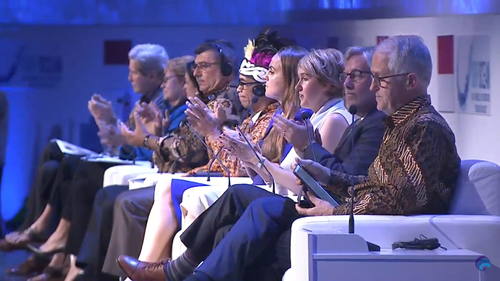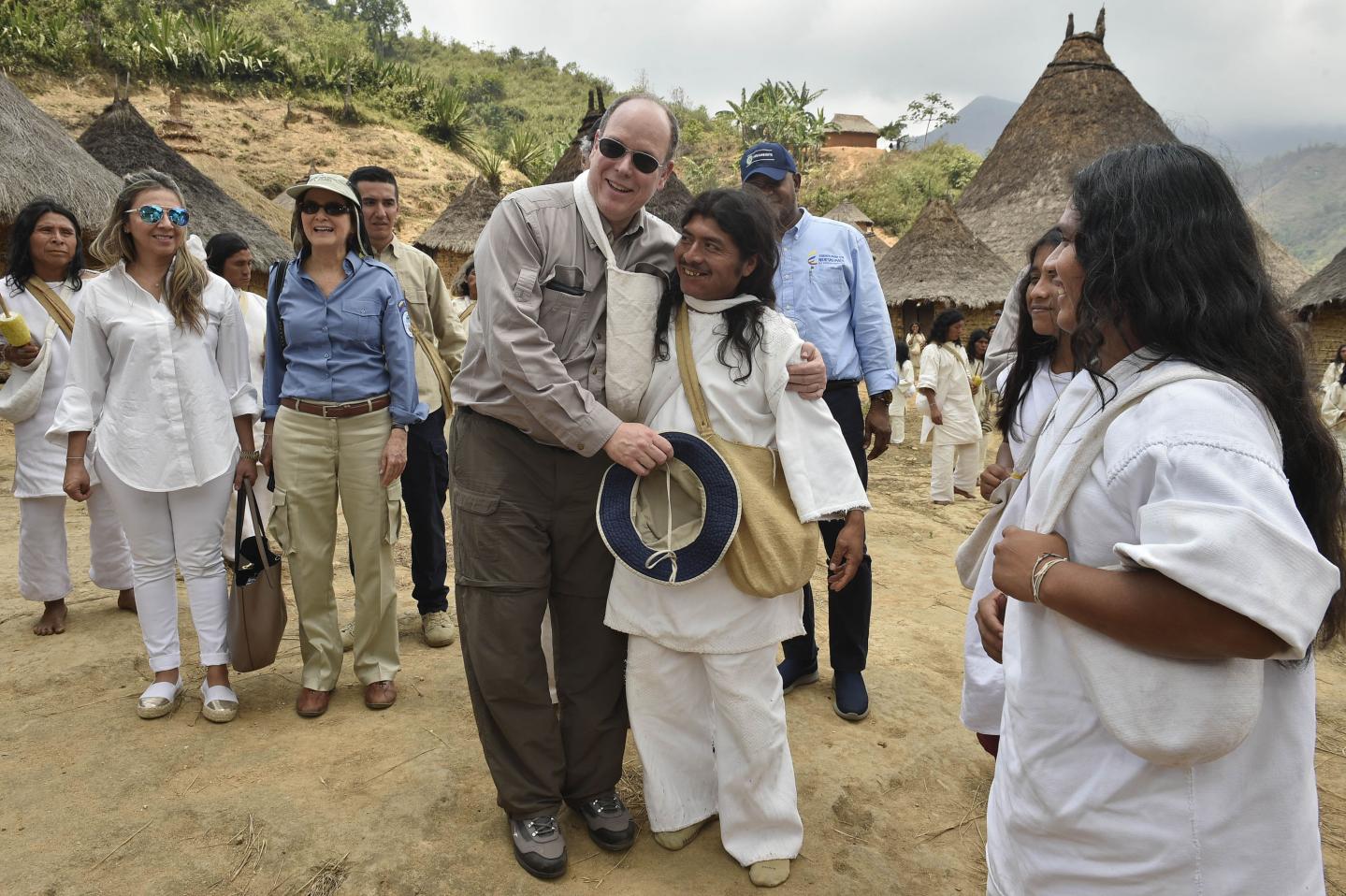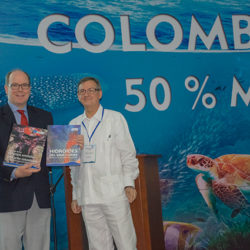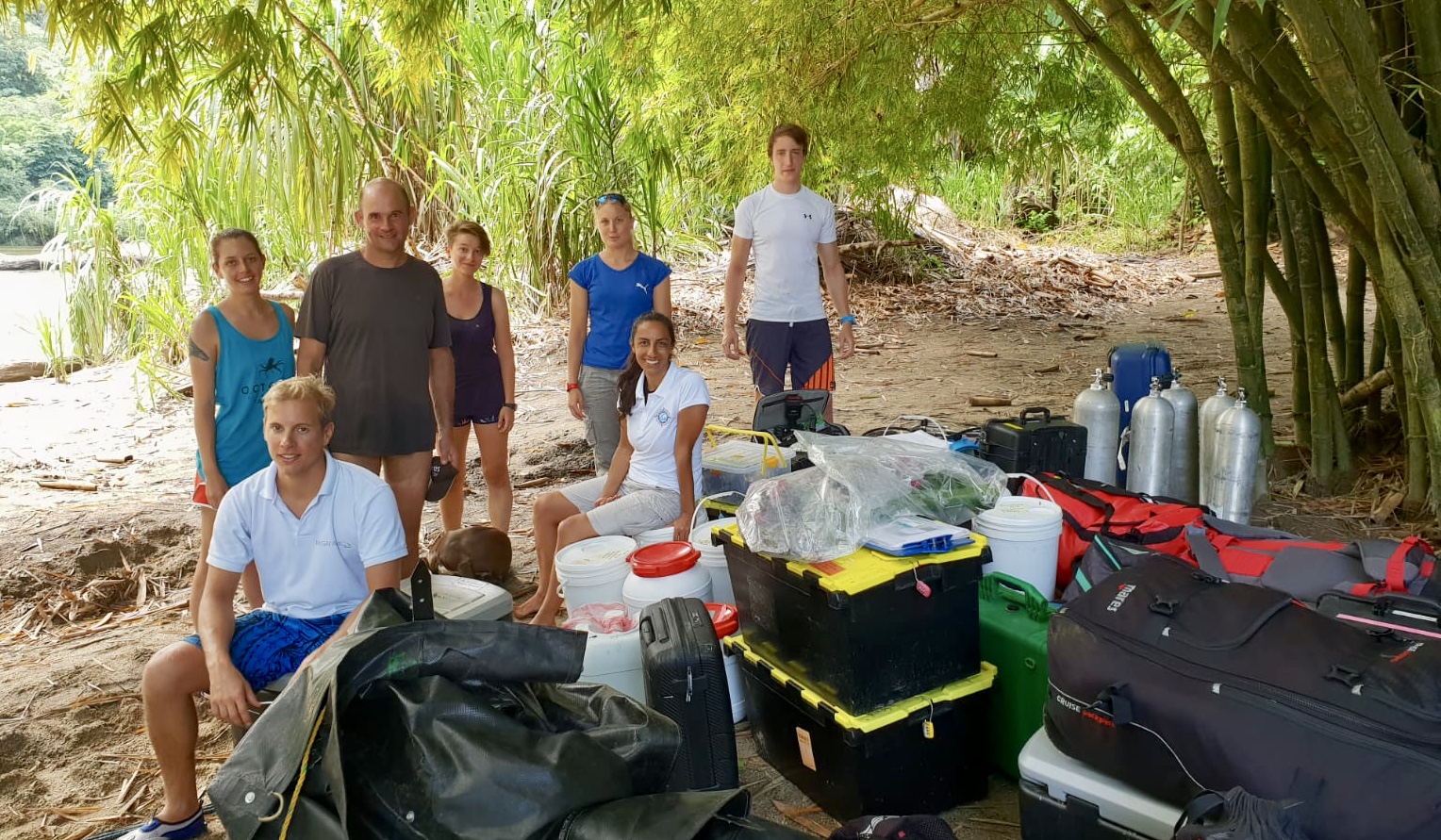
June 25 to July 8, 2018.
October 13 to 28, 2018
Caribbean Sea – Atlantic Missions
- Acidification des océans, ADN environnemental, Biodiversity, Marine Protected Areas, Nouvelles techniques d’exploration, Protection de la mégafaune
Megafaune Project: new milestones in Colombia
From June 25 to July 8, 2018 on Providencia Island, then from October 13 to 28, 2018 in Santa Marta, Colombian teams fromINVEMAR (Institute of Marine and Coastal Research) and European teams from the Megafauna project, supported by Explorations de Monaco, made another stopover in Colombia, following the mission to Malpelo in March-April 2018.
This time, the investigations were conducted on the Caribbean side.
The mission’s objectives were to complete the database of fish species that scientists are building up worldwide.
To this end, three techniques were used in the two areas studied:
- Sampling fish species by capture,
- Video recordings to assess the biodiversity present,
- Seawater sampling at various depths and filtration for environmental DNA (eDNA) analysis.
These two missions, like the one to Malpelo in March 2018, were part of an overall context of international cooperation between Colombia and the Principality of Monaco around major environmental issues.
Régis Hocdé: the interview summary
Régis Hocdé was, along with his Colombian counterpart Andréa Polanco , the scientific referent for the Santa Marta mission.
In this interview, he explains the ins and outs of the missions organized in Colombia; the new environmental DNA technology and the other techniques used during the Santa Marta and Providencia missions to survey biodiversity: seawater filtration, underwater cameras, species capture and sampling.
The aims and objectives of the project are also discussed.
Location
Santa Marta: the study of an unknown region
Adjacent to the protected terrestrial zone of the Sierra Nevada de Santa Marta National Natural Park, the marine zone studied during the mission has no special status to date, and is not protected.
Until now, it was totally unknown to Colombian and international scientists in terms of bathymetry, marine ecosystem distribution and biodiversity.
Its ecological interest could justify extending the protection of the terrestrial park to the maritime zone.
The results of the research carried out will provide the basis for this decision.

Providencia: satisfactory results
During the 7 days of the mission on Providencia Island, 10 dives of 40 to 80 minutes each were carried out at depths of 5 to 10 meters.
186 fish, belonging to 14 families and 33 different species, were captured to enrich the environmental DNA reference database.
Each fish was photographed, measured under standardized conditions and a fin sample taken for DNA analysis and sequencing at ETH Zurich and Spygen.
At the same time, 10 transects of environmental DNA sampling by seawater filtration were carried out around the island.
The political framework of the Colombian missions
During His official visit to Colombia from March 19 to 22, 2018, H.S.H. Prince Albert II of Monaco discussed major environmental issues with the President of the Republic of Colombia Juan Manuel Santos, including the following points:
– protection of the marine environment in the Pacific (Malpelo) and Caribbean Seas,
– the allocation of new lands to the Kogi people, the native inhabitants of the Sierra Nevada,
– protection of the equatorial forests, in the face of growing logging pressure, following the peace agreements signed between the government and the FARCS.
Meeting the Kogi Indians
Prince Albert II’s official visit in March 2018 coincided with the Colombian president signing an agreement to protect over 400,000 hectares in the Sierra Nevada de Santa Marta, where there will be no mining.
Water sources will also be preserved, in the interests of conservation in the face of climate change, for indigenous populations.
Together with Colombian President Santos, HSH Prince Albert II met the tribes of the Ciudad Perdida site, founded 800 years after Jesus Christ © César Carrión/Presidency of the Colombian Republic.
The Kogis have managed to preserve a traditional way of life, where the relationship with nature is harmonious and rich in lessons that Western peoples should learn from.
This type of encounter is a key aspect of Explorations de Monaco, as it highlights the role that communities can play in sustainable development and environmental protection.

March 19, 2018: meeting on ocean acidification in Santa Marta
On March 19, 2018, the Sovereign participated in Santa Marta in the 1st Regional Meeting of the International Reference User Group on Ocean Acidification (RUG)organized at INVEMAR – Institute for Marine and Coastal Research, on the theme “Encouraging collaboration and inspiring action – addressing the effects of ocean acidification in Latin America and the Caribbean”.
14 Latin American and Caribbean countries took part in the meeting, which ran until March 21.
Organized by the IUCNthis important meeting was funded by the Prince Albert II of Monaco Foundation and supported by the International Atomic Energy Agency (IAEA). The meeting was also part of the broader context of theInternational Year of Coral Reefs .

The Monaco Declaration: 10 years on
Ten years after the Monaco Declaration, which first alerted the world to the issue of ocean acidification, the Sovereign, in his address to the RUG meeting, highlighted the opportunity presented by the International Year of Coral Reefs in 2018.
Because of their sensitivity to acidification and their importance in global systems, corals must now, more than ever, be at the heart of our strategies.
H.S.H. Albert II of Monaco, March 19, 2018.
Related articles



- ·
Monaco Explorations in the Caribbean
Photo gallery
Installation of a vertical net to capture and sample fish © Olivier Borde.
Monaco Explorations.
The filters containing the eDNA fragments are packaged and sent to the lab for analysis © Olivier Borde.
Explorations in Monaco
Each diver is equipped with a small net to catch the fish © Olivier Borde.
Monaco Explorations.
View of the Sierra Nevada de Santa Marta National Park © Olivier Borde.
Monaco Explorations
Deployment and installation of the large bottom net.
Santa Marta, October 2018 © Olivier Borde.
Monaco Explorations.
Seawater is filtered to recover the eDNA fragments present in the water © Olivier Borde.
Monaco Explorations
Caribbean stonefish, Scorpaena plumieri © Olivier Borde.
Explorations de Monaco.
ADNe-Jean-Baptiste Juhel and Régis Hocdé prepare a Niskin bottle.
The water taken from the bottle will then be filtered © Olivier Borde.
Monaco Explorations
Parrotfish, female Sparisoma viride © Olivier Borde.
Monaco Explorations.
The coastal strip of the Sierra Nevada de Santa Marta National Park, Colombia © Olivier Borde.
Monaco Explorations
French angelfish, Pomancathus paru © Olivier Borde.
Explorations of Monaco
Coral reef, Caribbean Sea, Santa Marta © Olivier Borde.
Monaco Explorations.
Morphometric analysis: samples taken for the eDNA bank and measurements of specimens captured during diving © Olivier Borde.
Explorations de Monaco.
Providencia Island from the sea, Colombia © Explorations de Monaco
Bad weather in Providencia.
Jean-Baptiste Juhel.
© Explorations de Monaco
Providencia Island, Colombia.
A message to save the seas.
© Explorations de Monaco
Colombia, a land of megadiversity
With its coral reefs, mangroves, tropical rainforests, mountainous terrain and corridors (Mesoamerican Biological Corridor, Tropical East Pacific Marine Corridor), Colombia is one of the 17 megadiverse countries identified byUNEP-WCMC.
These countries contain the majority of the world’s living species and are considered the richest in biological diversity on the planet.
The 5 other South American megadiverse countries are Brazil, Ecuador, Mexico, Peru and Venezuela.
Scientific organization created on December 22, 1993.
Headquarters: Santa Marta, Magdalena, Colombia.
Ministry: Ministry of the Environment and Sustainable Development.
Four main lines of research
Biodiversity and marine ecosystems
Generate information and knowledge about marine and coastal biodiversity, and the phenomena and processes that govern it, to comply with the commitments of the Convention on Biological Diversity and national biodiversity policy.
Quality of the marine environment
Analyze the impact of natural phenomena and anthropogenic stress factors on marine ecosystems.
Study the causes, effects and possible solutions to problems linked to marine pollution.
Propose actions to restore marine and coastal ecosystems where necessary.
Marine and coastal geosciences
To study the climatic, oceanographic and geological phenomena and processes that modulate the dynamics of the coasts, the open sea and its ecosystems, using tools equipped with the latest technologies, in order to support sustainable development, planning and protection of the marine environment of national interest.
Assessment and use of marine and coastal resources
Assess the situation and the biological, economic and social potential of marine and coastal natural resources for their conservation and sustainable use.
Members of the Santa Marta and Providencia missions
Mission members in Santa Marta
Two scientific referents
Andrea Polanco, INVEMAR, Santa Marta, Colombia,
Régis Hocdé, IRD MARBEC, Montpellier, France, MEGAFAUNA team
A team of 10
INVEMAR, Santa Marta, Colombia
Maria Mutisbiologist (sea turtles, marine mammals, birds)
2 boat drivers.
UMR MARBEC, University of Montpellier France, MEGAFAUNE team
Virginie Marques (diver), Eva Maire (diver), Jean-Baptiste Juhel (ADNe), Marie-Charlotte Cheutin (sample processing)
ETH Zurich, Switzerland, MEGAFAUNA team
Manuel Spescha (diver)
Explorations of Monaco
Olivier Borde (cameraman, photographer, diver).
Mission members on Providencia Island
Two scientific referents
Andrea Polanco (diver), INVEMAR, Santa Marta, Colombia, researcher
Camille Pierre Albouy, Megafauna Team, Ifremer researcher, UMR MARBEC, mission leader, diver, France
A team of 4
INVEMAR, Santa Marta, Colombia
Giomar Helena Borrero Perez, researcher
MARBEC, University of Montpellier France, MEGAFAUNA team
Camille, Nathalie, Marie SENN (Professional diver)
Jean-Baptiste Juhel (ADNe filtration)
